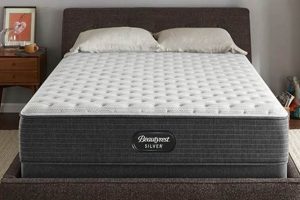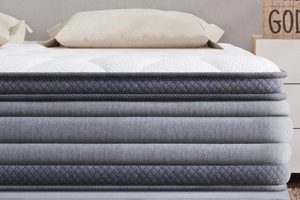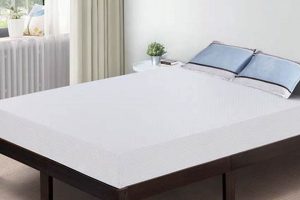The dimensional attributes of a standard double bed typically encompass a width of approximately 54 inches and a length of roughly 75 inches. These figures represent the industry-accepted norms, although slight variations may occur depending on the manufacturer and specific design.
Understanding these dimensions is crucial for various reasons. Accurate knowledge facilitates informed purchasing decisions, ensuring compatibility with existing bedroom furniture and optimal utilization of available space. Furthermore, awareness of the size specifications aids in the selection of appropriate bedding, such as sheets, comforters, and mattress protectors, guaranteeing a proper fit and enhancing the overall sleep experience. Historically, this particular bed size has offered a comfortable compromise between single and larger sleeping surfaces, accommodating individuals who require more space than a twin bed provides but find a queen or king size bed excessive for their needs or room size.
The following sections will delve into more specific aspects of selecting a bed, including considerations for different body types, sleeping habits, and available space, as well as exploring alternative mattress sizes and their respective advantages.
Considerations for Selecting an Appropriately Sized Bed
The following guidelines provide practical advice for choosing a bed that aligns with individual needs and spatial limitations. Careful consideration of these factors ensures a comfortable and functional sleep environment.
Tip 1: Room Dimensions. Measure the available floor space prior to purchase. Ensure sufficient clearance for movement around the bed and opening doors or drawers.
Tip 2: Individual Sleeper Size. Assess the size of the individual who will be using the bed. Taller individuals may require a longer mattress to ensure adequate support.
Tip 3: Sleeping Habits. Consider preferred sleeping positions. Individuals who tend to move frequently during sleep may benefit from a larger sleep surface.
Tip 4: Budgetary Constraints. Establish a realistic budget before beginning the search. Prices can vary significantly depending on materials, construction, and brand.
Tip 5: Frame Compatibility. Verify that the bed frame is designed to accommodate the specific mattress being considered. Incompatible frames can compromise support and void warranties.
Tip 6: Material Preferences. Explore different mattress materials, such as memory foam, innerspring, or latex, and their respective properties regarding comfort, support, and temperature regulation.
Tip 7: Firmness Level. Determine the optimal firmness level based on personal preference and any existing musculoskeletal conditions. Medium-firm mattresses often provide a balance of support and pressure relief.
Implementing these strategies promotes a well-informed decision, culminating in the selection of a bed that maximizes comfort, optimizes space, and supports restful sleep.
The subsequent section will provide a comprehensive overview of various mattress types, highlighting their distinguishing characteristics and suitability for diverse sleep needs.
1. Standard dimensions
The “standard dimensions” are the defining characteristics of the “measurement of a full mattress.” Without adherence to these established measurements, specifically 54 inches in width and 75 inches in length, a mattress cannot be accurately classified as a standard double. The existence of these fixed dimensions enables manufacturers to produce compatible bed frames and bedding accessories. For example, a bed frame designed for a double mattress will not properly accommodate a mattress exceeding or falling short of these standard measurements, potentially leading to structural instability and compromised support. Similarly, standard double-sized sheets are manufactured to precisely fit a mattress adhering to these dimensional specifications, preventing looseness or tightness that can detract from comfort.
The enforcement of these standards simplifies the consumer experience, ensuring that products marketed as “double” or “full” are consistent in size across different brands and retailers. This dimensional standardization allows consumers to confidently purchase mattresses, frames, and bedding without the need for precise, pre-purchase measurements of each individual item. The practical significance extends to logistical considerations such as shipping and storage, where standardized dimensions facilitate efficient handling and space utilization.
In summary, the “standard dimensions” are an integral and indispensable component of the “measurement of a full mattress.” They are the foundation upon which compatibility, convenience, and structural integrity are built. Challenges arise when manufacturers deviate from these established standards, leading to consumer frustration and potential safety concerns. Upholding dimensional consistency is therefore crucial for maintaining industry standards and ensuring consumer satisfaction.
2. Width
The dimension of “Width: 54 inches” is a fundamental element in defining the dimensional characteristics associated with the “measurement of a full mattress.” This specific width contributes directly to the classification of a mattress as a standard double, influencing its suitability for various applications and user demographics.
- Spatial Accommodation
The 54-inch width dictates the spatial requirements of the mattress within a bedroom or living space. This dimension directly impacts the layout and arrangement of furniture, influencing the perceived spaciousness and functionality of the room. For smaller bedrooms, this width provides a balance between sleeping area and available floor space.
- Sleeper Capacity
This width generally accommodates one to two sleepers, depending on their size and sleeping preferences. It offers sufficient space for a single adult or a couple who prefer a smaller sleeping surface. The 54-inch dimension provides a compromise between the compactness of a twin-sized mattress and the greater spaciousness of a queen-sized mattress.
- Bedding Compatibility
The 54-inch width is a standardized dimension for bedding manufacturers. Sheets, blankets, and comforters are produced to specifically fit mattresses with this width, ensuring a proper fit and preventing excessive fabric overhang or insufficient coverage. Adherence to this standard facilitates convenient and cost-effective procurement of bedding accessories.
- Frame Design
Bed frames designed to accommodate a double mattress are specifically constructed to support a mattress with a width of 54 inches. This dimensional compatibility ensures structural stability and prevents mattress slippage or uneven weight distribution. Selecting an appropriately sized frame is crucial for maintaining the longevity and support characteristics of the mattress.
These facets collectively emphasize the critical role of the 54-inch width in defining the “measurement of a full mattress.” It governs spatial considerations, sleeper capacity, bedding compatibility, and frame design, ultimately influencing the overall functionality and user experience associated with this mattress size. Knowledge of this dimension is essential for making informed purchasing decisions and optimizing the utilization of available space.
3. Length
The “Length: 75 inches” represents an indispensable linear measurement within the comprehensive “measurement of a full mattress.” This dimension, consistently applied across standardized double mattresses, directly influences the accommodation of the occupant’s height, thereby dictating the overall comfort and suitability for individual sleep requirements. A deficiency in this length compromises the ergonomic integrity of the sleeping surface, potentially leading to discomfort, restricted movement, and disrupted sleep patterns. For example, an individual exceeding approximately 5′ 10″ in height may experience constrained leg extension, resulting in suboptimal spinal alignment and decreased sleep quality. Conformance to the 75-inch standard ensures that a broad segment of the adult population can comfortably utilize this mattress size without encountering physical limitations imposed by insufficient length.
Beyond individual comfort, the “Length: 75 inches” impacts bed frame design and bedding compatibility. Bed frames designated for mattresses are engineered to precisely support the specific dimensions. A deviation from the 75-inch standard necessitates alterations to the frame design, potentially incurring additional manufacturing costs and posing compatibility challenges with existing bedding accessories. Bedding manufacturers adhere to standardized dimensions, producing sheets, blankets, and comforters tailored to fit mattresses of this length. Utilizing non-standard dimensions complicates the process of procuring compatible bedding, potentially requiring custom-made items, thus increasing expenses and logistical complexities. Therefore, maintaining this linear measurement ensures seamless integration with existing infrastructure and streamlines the consumer experience.
In summary, the “Length: 75 inches” serves as a critical and non-negotiable parameter within the “measurement of a full mattress.” It is foundational to the ergonomic suitability of the mattress for a wide range of individuals, directly affecting sleep comfort and overall well-being. Compliance with this dimension is equally essential for ensuring seamless compatibility with bed frames and bedding accessories, streamlining the purchasing process and mitigating potential logistical challenges. Adherence to the 75-inch length contributes significantly to the practicality and universal applicability of the standard double mattress size.
4. Depth Variations
The term “Depth Variations,” in the context of the “measurement of a full mattress,” pertains to the vertical dimension of the mattress, often referred to as its thickness or height. This dimension is not standardized to the same degree as the width and length, and it can significantly impact various aspects of mattress performance, aesthetics, and compatibility with bed frames and bedding.
- Impact on Support and Comfort
A greater mattress depth often corresponds to a more complex internal structure, potentially incorporating multiple layers of different materials designed to provide enhanced support and pressure relief. For instance, a thicker mattress may include a combination of high-density foam for support, memory foam for contouring, and a quilted top layer for added comfort. Conversely, a thinner mattress may offer less cushioning and may be more suitable for individuals who prefer a firmer sleeping surface or who have specific weight requirements. The depth, therefore, influences the overall feel and ergonomic properties of the sleep system.
- Compatibility with Bed Frames
The depth of a mattress directly affects its compatibility with various bed frame designs. Some bed frames, particularly those with headboards or footboards, are designed to accommodate mattresses of a specific depth. If a mattress is too thick, it may obscure the headboard or footboard, altering the aesthetic appearance of the bed. Conversely, if a mattress is too thin, it may not adequately fill the frame, potentially leading to an undesirable gap and compromising the structural integrity of the bed. Platform beds, which do not typically require a box spring, are particularly sensitive to mattress depth, as the mattress directly supports the sleeper’s weight.
- Bedding Fit and Aesthetics
Mattress depth also influences the fit and appearance of bedding, particularly fitted sheets. Standard fitted sheets are designed to accommodate a range of mattress depths, typically between 9 and 15 inches. If a mattress is significantly thicker or thinner than this range, standard fitted sheets may not fit properly, leading to difficulty in securing the sheet to the mattress or creating a loose, wrinkled surface. The depth also affects the overall aesthetic appearance of the bed, influencing the visual balance and proportionality of the bedding ensemble.
- Perceived Value and Material Composition
While not always indicative of quality, mattress depth can influence the perceived value of the product. Consumers often associate greater depth with higher quality materials and more sophisticated construction techniques. Manufacturers may utilize increased depth to incorporate additional layers of specialized materials, such as gel-infused memory foam or individually wrapped coils, which contribute to enhanced performance characteristics. However, it is essential to evaluate the material composition and construction quality, as depth alone does not guarantee superior performance.
In conclusion, “Depth Variations” represent a significant consideration within the broader context of “measurement of a full mattress.” While the width and length are standardized, the depth can vary substantially, influencing support, comfort, frame compatibility, bedding fit, and perceived value. Understanding these implications is crucial for making informed purchasing decisions and optimizing the overall sleep experience. For example, consumers should carefully evaluate the depth of a mattress in relation to their preferred sleeping position, weight, bed frame design, and bedding preferences to ensure optimal comfort and functionality.
5. Frame compatibility
Frame compatibility, in relation to the measurement of a full mattress, represents a critical element ensuring both structural integrity and intended functionality of a bed system. The dimensions of a mattress, specifically its width, length, and, to a lesser extent, depth, dictate the required internal dimensions of the bed frame designed to support it. A frame that is either too large or too small relative to the mattress’s dimensions will result in inadequate support, potential mattress slippage, and ultimately, compromised sleep quality. For instance, a frame designed for a queen-sized mattress will not properly accommodate a full-sized mattress, leading to unsupported edges and premature wear of the mattress.
The absence of proper frame compatibility can manifest in several practical problems. Squeaking or other noises may arise from the movement of the mattress within an ill-fitting frame. The structural stability of the entire bed system is also jeopardized, increasing the risk of frame damage or even collapse. Furthermore, improper support can negatively impact the sleeper’s spinal alignment, potentially exacerbating or contributing to musculoskeletal issues. Bedding manufacturers recognize the importance of standardization in mattress dimensions and produce accessories such as fitted sheets and mattress protectors accordingly. Non-compliant frame dimensions undermine these standards, leading to difficulties in securing bedding and compromising the overall aesthetic appeal of the bed.
In summary, frame compatibility is an inseparable component of the measurement of a full mattress. Adherence to standardized dimensions ensures the secure support, proper function, and longevity of the bed system. Deviations from these standards can lead to a cascade of negative consequences, ranging from compromised comfort and structural instability to difficulties with bedding compatibility. The accurate measurement and selection of both mattress and frame are therefore essential for optimizing sleep quality and preventing potential safety hazards.
Frequently Asked Questions Regarding the Dimensions of a Standard Double Bed
This section addresses common inquiries concerning the dimensional specifications of a standard double bed, offering clarity and dispelling potential misconceptions.
Question 1: What are the precise measurements defining a “full” mattress?
A standard double mattress conforms to a width of approximately 54 inches and a length of approximately 75 inches. These dimensions are generally consistent across manufacturers, although slight variations may occur.
Question 2: Does mattress depth influence the classification of a “full” size?
While the width and length are defining characteristics, the depth (or thickness) of a mattress does not determine its classification as a “full” size. Depth can vary significantly depending on the construction and materials used.
Question 3: Are “full” size mattresses and “double” mattresses dimensionally identical?
Yes, the terms “full” and “double” are used interchangeably to describe a mattress with dimensions of approximately 54 inches by 75 inches. No dimensional difference exists between these designations.
Question 4: Why is adherence to standardized dimensions crucial for purchasing a “full” size mattress?
Adherence to standard dimensions ensures compatibility with bed frames and bedding accessories designed specifically for this size. Deviations from these dimensions may result in improper fit and compromised support.
Question 5: How do the dimensions of a “full” mattress compare to those of a “queen” mattress?
A “queen” mattress is significantly larger than a “full” mattress. A queen typically measures 60 inches in width and 80 inches in length, offering greater sleeping space for individuals or couples.
Question 6: What factors should be considered when determining if a “full” size mattress is appropriate?
Room size, individual sleeper size, and sleeping habits are primary considerations. A full mattress provides adequate space for a single sleeper or a couple who prefer a smaller sleeping surface and have limited room dimensions.
The consistent adherence to these dimensional parameters facilitates informed purchasing decisions and ensures the harmonious integration of the mattress with associated components.
The subsequent segment of this document will provide a comparative analysis of various mattress sizes, highlighting their respective advantages and limitations.
Measurement of a Full Mattress
This article has systematically examined the defining characteristics inherent in the measurement of a full mattress. The established dimensions, 54 inches in width and 75 inches in length, represent a critical standard governing compatibility with bed frames and bedding accessories. Deviations from these established measurements disrupt the integrity of the sleep system, potentially leading to compromised support and premature wear. The depth variations, while not standardized, influence the overall comfort and aesthetic considerations, necessitating careful evaluation during the selection process. Frame compatibility is paramount, ensuring the secure support and longevity of the mattress.
Understanding the nuances of these measurements enables informed decision-making, fostering a pragmatic approach to selecting a mattress that aligns with individual needs and spatial constraints. Ongoing adherence to these established standards will continue to contribute to a consistent and predictable consumer experience. The diligent application of these principles promotes the procurement of a sleep solution optimized for both comfort and long-term value.



![Best Intex Full Size Inflatable Mattress - [Year] Guide Organic & Natural Mattress Buyer’s Guide: Non-Toxic Sleep Solutions Best Intex Full Size Inflatable Mattress - [Year] Guide | Organic & Natural Mattress Buyer’s Guide: Non-Toxic Sleep Solutions](https://mattressworldpa.com/wp-content/uploads/2025/07/th-2780-300x200.jpg)
![Choosing the Right Bunk Bed Mattress Full Size [Guide] Organic & Natural Mattress Buyer’s Guide: Non-Toxic Sleep Solutions Choosing the Right Bunk Bed Mattress Full Size [Guide] | Organic & Natural Mattress Buyer’s Guide: Non-Toxic Sleep Solutions](https://mattressworldpa.com/wp-content/uploads/2025/07/th-2779-300x200.jpg)


